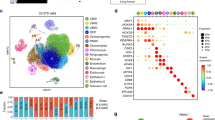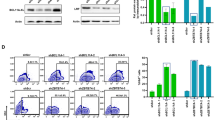Abstract
Loss of gene function is a valuable tool for screening genes in cellular processes including stem cell differentiation differentiation. However, the criteria for evaluating gene knockdown are usually based on end-point analysis and real-time, dynamic information is lacking. To overcome these limitations, we engineered a shRNA encoding LentiViral Dual Promoter vector (shLVDP) that enabled real-time monitoring of mesenchymal stem (MSC) differentiation and simultaneous gene knockdown. In this vector, the activity of the alpha-smooth muscle actin (αSMA) promoter was measured by the expression of a destabilized green fluorescent protein, and was used as an indicator of myogenic differentiation; constitutive expression of discosoma red fluorescent protein was used to measure transduction efficiency and to normalize αSMA promoter activity; and shRNA was encoded by a doxycycline (Dox)-regulatable H1 promoter. Importantly, the normalized promoter activity was independent of lentivirus titer allowing quantitative assessment of gene knockdown. Using this vector, we evaluated 11 genes in the TGF-β1 or Rho signaling pathway on SMC maturation and on MSC differentiation along the myogenic lineage. As expected, knockdown of genes such as Smad2/3 or RhoA inhibited myogenic differentiation, while knocking down the myogenic differentiation inhibitor, Klf4, increased αSMA promoter activity significantly. Notably, some genes for example, Smad7 or KLF4 showed differential regulation of myogenic differentiation in MSC from different anatomic locations such as bone marrow and hair follicles. Finally, Dox-regulatable shRNA expression enabled temporal control of gene knockdown and provided dynamic information on the effect of different genes on myogenic phenotype. Our data suggests that shLVDP may be ideal for development of lentiviral microarrays to decipher gene regulatory networks of complex biological processes such as stem cell differentiation or reprogramming.
This is a preview of subscription content, access via your institution
Access options
Subscribe to this journal
Receive 12 print issues and online access
$259.00 per year
only $21.58 per issue
Buy this article
- Purchase on Springer Link
- Instant access to full article PDF
Prices may be subject to local taxes which are calculated during checkout







Similar content being viewed by others
References
Zhou LL, Zhao Y, Ringrose A, DeGeer D, Kennah E, Lin AE et al. AHI-1 interacts with BCR-ABL and modulates BCR-ABL transforming activity and imatinib response of CML stem/progenitor cells. J Exp Med 2008; 205: 2657–2671.
Velkey JM, O’Shea KS . Oct4 RNA interference induces trophectoderm differentiation in mouse embryonic stem cells. Genesis 2003; 37: 18–24.
Zou GM, Chan RJ, Shelley WC, Yoder MC . Reduction of Shp-2 expression by small interfering RNA reduces murine embryonic stem cell-derived in vitro hematopoietic differentiation. Stem Cells 2006; 24: 587–594.
Zou GM, Luo MH, Reed A, Kelley MR, Yoder MC . Ape1 regulates hematopoietic differentiation of embryonic stem cells through its redox functional domain. Blood 2007; 109: 1917–1922.
Angaji SA, Hedayati SS, Poor RH, Madani S, Poor SS, Panahi S . Application of RNA interference in treating human diseases. J Genet 2010; 89: 527–537.
Paddison PJ, Silva JM, Conklin DS, Schlabach M, Li M, Aruleba S et al. A resource for large-scale RNA-interference-based screens in mammals. Nature 2004; 428: 427–431.
Foley E, O’Farrell PH . Functional dissection of an innate immune response by a genome-wide RNAi screen. PLoS Biol 2004; 2: E203.
Moffat J, Grueneberg DA, Yang X, Kim SY, Kloepfer AM, Hinkle G et al. A lentiviral RNAi library for human and mouse genes applied to an arrayed viral high-content screen. Cell 2006; 124: 1283–1298.
Kittler R, Surendranath V, Heninger AK, Slabicki M, Theis M, Putz G et al. Genome-wide resources of endoribonuclease-prepared short interfering RNAs for specific loss-of-function studies. Nat Methods 2007; 4: 337–344.
Silva JM, Mizuno H, Brady A, Lucito R, Hannon GJ . RNA interference microarrays: high-throughput loss-of-function genetics in mammalian cells. Proc Natl Acad Sci USA 2004; 101: 6548–6552.
Brass AL, Dykxhoorn DM, Benita Y, Yan N, Engelman A, Xavier RJ et al. Identification of host proteins required for HIV infection through a functional genomic screen. Science 2008; 319: 921–926.
Konig R, Zhou Y, Elleder D, Diamond TL, Bonamy GM, Irelan JT et al. Global analysis of host-pathogen interactions that regulate early-stage HIV-1 replication. Cell 2008; 135: 49–60.
Krishnan MN, Ng A, Sukumaran B, Gilfoy FD, Uchil PD, Sultana H et al. RNA interference screen for human genes associated with West Nile virus infection. Nature 2008; 455: 242–245.
Yeung ML, Houzet L, Yedavalli VS, Jeang KT . A genome-wide short hairpin RNA screening of jurkat T-cells for human proteins contributing to productive HIV-1 replication. J Biol Chem 2009; 284: 19463–19473.
Echard A, Hickson GR, Foley E, O′Farrell PH . Terminal cytokinesis events uncovered after an RNAi screen. Curr Biol 2004; 14: 1685–1693.
Mukherji M, Bell R, Supekova L, Wang Y, Orth AP, Batalov S et al. Genome-wide functional analysis of human cell-cycle regulators. Proc Natl Acad Sci USA 2006; 103: 14819–14824.
Collinet C, Stoter M, Bradshaw CR, Samusik N, Rink JC, Kenski D et al. Systems survey of endocytosis by multiparametric image analysis. Nature 2010; 464: 243–249.
Zhang JZ, Gao W, Yang HB, Zhang B, Zhu ZY, Xue YF . Screening for genes essential for mouse embryonic stem cell self-renewal using a subtractive RNA interference library. Stem Cells 2006; 24: 2661–2668.
Ngo VN, Davis RE, Lamy L, Yu X, Zhao H, Lenz G et al. A loss-of-function RNA interference screen for molecular targets in cancer. Nature 2006; 441: 106–110.
Sheng Z, Li L, Zhu LJ, Smith TW, Demers A, Ross AH et al. A genome-wide RNA interference screen reveals an essential CREB3L2-ATF5-MCL1 survival pathway in malignant glioma with therapeutic implications. Nat Med 2010; 16: 671–677.
Tian J, Alimperti S, Lei P, Andreadis ST . Lentiviral microarrays for real-time monitoring of gene expression dynamics. Lab Chip 2010; 10: 1967–1975.
Tian J, Andreadis ST . Independent and high-level dual-gene expression in adult stem-progenitor cells from a single lentiviral vector. Gene Therapy 2009; 16: 874–884.
Hautmann MB, Madsen CS, Owens GK . A transforming growth factor beta (TGFbeta) control element drives TGFbeta-induced stimulation of smooth muscle alpha-actin gene expression in concert with two CArG elements. J Biol Chem 1997; 272: 10948–10956.
Kinner B, Zaleskas JM, Spector M . Regulation of smooth muscle actin expression and contraction in adult human mesenchymal stem cells. Exp Cell Res 2002; 278: 72–83.
Wang D, Park JS, Chu JS, Krakowski A, Luo K, Chen DJ et al. Proteomic profiling of bone marrow mesenchymal stem cells upon transforming growth factor beta1 stimulation. J Biol Chem 2004; 279: 43725–43734.
Mack CP, Somlyo AV, Hautmann M, Somlyo AP, Owens GK . Smooth muscle differentiation marker gene expression is regulated by RhoA-mediated actin polymerization. J Biol Chem 2001; 276: 341–347.
Szulc J, Wiznerowicz M, Sauvain MO, Trono D, Aebischer P . A versatile tool for conditional gene expression and knockdown. Nat Methods 2006; 3: 109–116.
Wiznerowicz M, Trono D . Conditional suppression of cellular genes: lentivirus vector-mediated drug-inducible RNA interference. J Virol 2003; 77: 8957–8961.
ter Brake O, t Hooft K, Liu YP, Centlivre M, von Eije KJ, Berkhout B . Lentiviral vector design for multiple shRNA expression and durable HIV-1 inhibition. Mol Ther 2008; 16: 557–564.
Owens GK, Kumar MS, Wamhoff BR . Molecular regulation of vascular smooth muscle cell differentiation in development and disease. Physiol Rev 2004; 84: 767–801.
Massague J . Receptors for the TGF-beta family. Cell 1992; 69: 1067–1070.
Ng F, Boucher S, Koh S, Sastry KS, Chase L, Lakshmipathy U et al. PDGF, TGF-beta, and FGF signaling is important for differentiation and growth of mesenchymal stem cells (MSCs): transcriptional profiling can identify markers and signaling pathways important in differentiation of MSCs into adipogenic, chondrogenic, and osteogenic lineages. Blood 2008; 112: 295–307.
Mack CP, Somlyo AV, Hautmann M, Somlyo AP, Owens GK . Smooth muscle differentiation marker gene expression is regulated by RhoA-mediated actin polymerization. J Biol Chem 2001; 276: 341–347.
Zhang YE . Non-Smad pathways in TGF-beta signaling. Cell Res 2009; 19: 128–139.
Larsson E, Zhou X, Akyurek LM . RhoA-dependent vascular smooth muscle cell-specific transcription: adding diaphanous formins to the puzzle. Arterioscler Thromb Vasc Biol 2007; 27: 448–449.
Wang D, Chang PS, Wang Z, Sutherland L, Richardson JA, Small E et al. Activation of cardiac gene expression by myocardin, a transcriptional cofactor for serum response factor. Cell 2001; 105: 851–862.
Wang DZ, Li S, Hockemeyer D, Sutherland L, Wang Z, Schratt G et al. Potentiation of serum response factor activity by a family of myocardin-related transcription factors. Proc Natl Acad Sci USA 2002; 99: 14855–14860.
Wang DZ, Olson EN . Control of smooth muscle development by the myocardin family of transcriptional coactivators. Curr Opin Genet Dev 2004; 14: 558–566.
Liu Y, Sinha S, McDonald OG, Shang Y, Hoofnagle MH, Owens GK . Kruppel-like factor 4 abrogates myocardin-induced activation of smooth muscle gene expression. J Biol Chem 2005; 280: 9719–9727.
Qiu P, Feng XH, Li L . Interaction of Smad3 and SRF-associated complex mediates TGF-beta1 signals to regulate SM22 transcription during myofibroblast differentiation. J Mol Cell Cardiol 2003; 35: 1407–1420.
Edlund S, Landstrom M, Heldin CH, Aspenstrom P . Smad7 is required for TGF-beta-induced activation of the small GTPase Cdc42. J cell sci 2004; 117: 1835–1847.
Miyake T, Alli NS, McDermott JC . Nuclear function of Smad7 promotes myogenesis. Mol cell biol 2010; 30: 722–735.
Wiederschain D, Wee S, Chen L, Loo A, Yang G, Huang A et al. Single-vector inducible lentiviral RNAi system for oncology target validation. Cell Cycle 2009; 8: 498–504.
Dickins RA, Hemann MT, Zilfou JT, Simpson DR, Ibarra I, Hannon GJ et al. Probing tumor phenotypes using stable and regulated synthetic microRNA precursors. Nat Genet 2005; 37: 1289–1295.
Beronja S, Livshits G, Williams S, Fuchs E . Rapid functional dissection of genetic networks via tissue-specific transduction and RNAi in mouse embryos. Nat Med 2010; 16: 821–827.
Pongratz C, Yazdanpanah B, Kashkar H, Lehmann MJ, Krausslich HG, Kronke M . Selection of potent non-toxic inhibitory sequences from a randomized HIV-1 specific lentiviral short hairpin RNA library. PloS one 2010; 5: e13172.
Liu JY, Peng HF, Andreadis ST . Contractile smooth muscle cells derived from hair-follicle stem cells. Cardiovasc Res 2008; 79: 24–33.
Liu JY, Peng HF, Gopinath S, Tian J, Andreadis ST . Derivation of functional smooth muscle cells from multipotent human hair follicle mesenchymal stem cells. Tissue Eng Part A 2010; 16: 2553–2564.
Han J, Liu JY, Swartz DD, Andreadis ST . Molecular and functional effects of organismal ageing on smooth muscle cells derived from bone marrow mesenchymal stem cells. Cardiovasc Res 2010; 87: 147–155.
Acknowledgements
This work was supported by grants from the National Heart and Lung Institute (R01 HL086582), the National Science Foundation (BES-0853993) and the New York Stem Cell Science Fund (NYSTEM, Contract# C024315) to STA.
Author information
Authors and Affiliations
Corresponding author
Ethics declarations
Competing interests
The authors declare no conflict of interest.
Additional information
Supplementary Information accompanies the paper on Gene Therapy website
Supplementary information
Rights and permissions
About this article
Cite this article
Alimperti, S., Lei, P., Tian, J. et al. A novel lentivirus for quantitative assessment of gene knockdown in stem cell differentiation. Gene Ther 19, 1123–1132 (2012). https://doi.org/10.1038/gt.2011.208
Received:
Revised:
Accepted:
Published:
Issue Date:
DOI: https://doi.org/10.1038/gt.2011.208
Keywords
This article is cited by
-
Endothelialization of arterial vascular grafts by circulating monocytes
Nature Communications (2020)
-
Lentiviral Arrays for Live-cell Dynamic Monitoring of Gene and Pathway Activity During Stem Cell Differentiation
Molecular Therapy (2014)
-
Construction and Quantitative Evaluation of a Dual Specific Promoter System for Monitoring the Expression Status of Stra8 and c-kit Genes
Molecular Biotechnology (2014)



